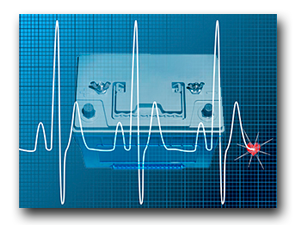Battery optimization
 In a plant PV or backup power for electricity, batteries represent a significant portion of the initial cost… and renewal and virtually the only operating cost.
In a plant PV or backup power for electricity, batteries represent a significant portion of the initial cost… and renewal and virtually the only operating cost.
Several phenomena (sulfatation, water loss, perte de masse…) limit the life of your batteries, but the use you made can dramatically accelerate their aging : nothing easier than putting out of use 2 weeks a battery designed to last several years. Here are some rules for avoid this mishap and prolong performance your batteries.
[spoiler title=”Never discharge the battery completely” open=”false” closebtn=”Close”]
The lifetime cycle decreases rapidly when the depth of discharge increases. Generally, trying to limiting the depth of discharge 50%, that is to say that one use only half of the capacity of batteries. Anyway, set a maximum depth of discharge during the design of the system and do not exceed. A battery monitor you will know the state of charge of your batteries and avoid exceeding the threshold by accident that you fixé.Lorsqu a battery is discharged, recharge it as soon as possible even if you do not plan to use right away. Attention to the self-discharge : if you store the batteries must be recharged regularly.
[/spoiler]
[spoiler title=”Limit the load current” open=”false” closebtn=”Close”]
The charging current must remain less than a quarter of the capacity of the battery (25A for a 100 Ah battery, 50A for a 200 Ah or 2 batteries 100Ah, etc.). Certainly a higher current can charge the battery faster but it will also speed up the weight loss and lead to a sharp rise in the temperature of the battery which will accelerate the wear especially if your system does not have temperature compensation.
[/spoiler]
[spoiler title=”Avoid partial refills and perform maintenance costs” open=”false” closebtn=”Close”]
If it is frequently used without being fully charged will create imbalances between the different elements of the battery which will lower performance.
To avoid this, must be from time to time fully charge the battery and keep a low charging current at its terminals. This slight overload, called maintenance charge, will help to correct imbalances between the different elements of the battery. For batteries with liquid electrolyte, overload will also cause a boil that will stir the electrolyte and prevent stratification.
Caution still for sealed batteries, excessive overload may lead to irreversible loss of water.
[/spoiler]
[spoiler title=”For flooded batteries : regularly check the water level” open=”false” closebtn=”Close”]
In an open battery, water can escape. It is therefore regularly monitor the level and if necessary top up with distilled water. Too low a level results in a decrease in battery capacity but also an increase in the concentration of acid (and hence accelerate corrosion).
The level should be checked at least once in a month.
[/spoiler]
[spoiler title=”Keep batteries in a cool ...” open=”false” closebtn=”Close”]
High temperatures accelerate the aging of the battery. Typically, the life of a battery is halved when the temperature increases 10°C.
Example :
A battery AGM whose life in 20°C is 8 years will :
- a life 6 years with 25°C
- and only 4 years with 30°C !
Even if you do not find yourself in a hot climate, it is important to do everything possible to limit the temperature of the batteries. Put them in a well ventilated to dissipate the heat generated by the batteries during charging and discharging local. Allow 10cm between batteries and put them on a pallet for example.
[/spoiler]
[spoiler title=”Consider the temperature” open=”false” closebtn=”Close”]
The charging voltage specified for your batteries is generally valid at 20 ° C. This value may be totally inappropriate if the ambient temperature higher, especially as the charge or discharge the battery produces heat (up to ten degree). It is therefore necessary to adapt the voltage. Temperature compensation varies from one model to another, but it is typically of the order of -24mV / ° C a battery for 12In.
Example :
If the manufacturer announces absorption voltage 14.4V for a 12V battery and the battery temperature is 40 ° C (temperature of 30 ° C + heat generated by the battery), charger should be set to an absorption voltage 13.9In. If this is not the case, the lifetime of the battery will be significantly reduced by corrosion and gassing.
This correction can be done automatically if you use a temperature probe.
If you are in a warm climate you can also reduce the concentration of acid in the electrolyte to slow down the corrosion.
[/spoiler]
To summarize, hold two recommendations :
-
Do not discharge your batteries too deep and do not let them unloaded,
-
Use a good quality charger and correctly set.


